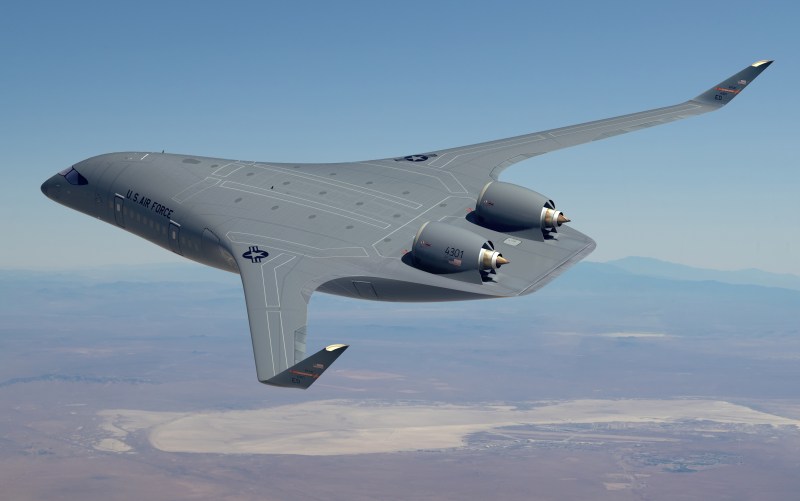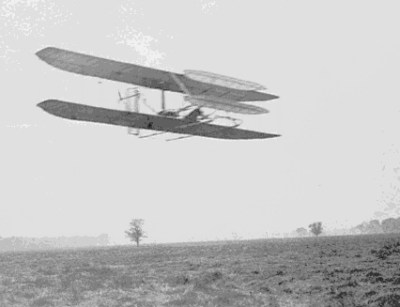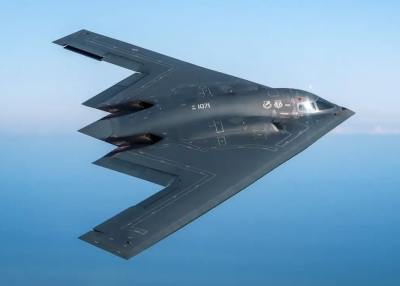

Ask someone to picture an airplane and they’re likely to think of what is essentially a tube with wings and a stabilizing tail tacked onto one end of said tube. Yet it is also no secret that the lift produced by such a tube is rather poor, even if they’re straightforward for loading cargo (static and self-loading) into them and for deciding where to put in windows. Over the decades a number of alternative airplane designs have been developed, with some of them also ending up being produced. Here most people are probably quite familiar with the US Air Force’s B-2 Spirit bomber and its characteristic flying wing design, while blended wing body (BWB) maintains a somewhat distinctive fuselage, as with for example the B-1 Lancer.
Outside of military airplanes BWBs are a pretty rare sight. Within the world of passenger airplanes the tube-with-wings pattern that the first ever passenger airplanes adopted has persisted with the newest designs, making it often tricky to distinguish one airplane from another. This could soon change, however, with a strong interest within the industry for passenger-oriented BWBs. The reason for this are the significant boosts in efficiency, quieter performance and more internal (useful) volume, which makes airline operators very happy, but which may also benefit passengers.
With that said, how close are we truly to the first BWB passenger airplane delivery to an airline?
Heavier Than Air Aerodynamics

When regarding the first ever airplanes to make a successful powered flight, in particular the Wright Flyer, it’s notable where the focus was put in the design. The Wright Flyer doesn’t have much of a fuselage, but is mostly wing, along with some means for control by changing the shape of the wings (wing warping) in addition to the dual elevators and rudders. As an early attempt at controlled (powered) flight, it rather mimicked the way that birds control their flight by changing the shape of their wings.
As airplane designs evolved and saw explosive growth throughout World War I with practically weekly new designs, we saw the appearance of the now familiar design with a distinct fuselage and control scheme including wing-mounted ailerons and similar methods. Bi- and tri-planes gave way to monoplanes, and especially for passenger jets the tube fuselage ended up being extremely useful as a way to add more internal capacity by lengthening said tube or widen it (so-called wide-body jets).
Despite experiments with early BWBs such as the 1924 Westland Dreadnought prototype, 1938’s Miles M.30, 1944’s McDonnell XP-67 interceptor and Canadian Burnelli CBY-3, only these last two saw significant usage, albeit with the XP-67 failing US Army trials. The single CBY-3 airplane that was built did see significant use as a commercial airliner until its retirement in 1964 after which it was restored and moved into the collection of the New England Air Museum in Windsor Locks, Connecticut.
With seemingly an endless string of failures and one quite unremarkable non-military airplane resulting from BWB research by the 1960s, one might be excused for thinking that the BWB advantages are mostly hot air. Here the designs that began to appear by the 1970s began to turn heads, however.
Trade-offs

The advantages of blending the wings into the body are obvious: it first of all reduces the wetting surface (i.e. the wetting aspect ratio), meaning that there’s less of the airplane’s structure interacting with the atmosphere and thus less drag. Second, it makes it possible to turn more or all of the fuselage into part of the airfoil, and thus have it too generate lift. The disadvantages mostly lie in that it makes controlling the airplane more complex as you abandon the inherent aerodynamic stability of a tube. The more extreme examples of this issue are found in both flying wings and lifting body design.
A flying wing design such as the Northrop B-2 Spirit bomber is a purely fly-by-wire design, as only the lightning-fast reflexes of a computerized system can keep what is ultimately an inherently unstable aerodynamic shape stable. This is an approach which was pioneered for a large part in the Lockheed F-117 airplane, which got referred to in such loving terms as for example ‘the flying brick’ due to its rather poor aerodynamic properties.
The move from a tube to a blended wing design can be likened to creating arrows that abandon the cylindrical shape for a blended fletching design: you lose the natural stability (and radar cross-section) that comes with a cylinder-with-fletching. This is of course great if you are designing an agile jet fighter that has to pull off dramatic course changes, or a long-distance (stealth) bomber, but less great if you’re designing a passenger airplane. In a naturally risk-averse industry like commercial aviation, this has kept airplane designs roughly as exciting and innovative as when the Boeing 737 first rolled off the production line, with mostly incremental tweaks and improvements, including to the engines.
End Of The Road

Within the limitations of the tube-with-wings design incredible feats of optimizations have been performed over the decades, with each successive generation being a bit more efficient and their engines more quiet and easier on fuel consumption. New gains within these same limitations are however becoming increasingly harder and more expensive, while a commercial BWB jet liner could see multi-digit percentage fuel savings, increase space for cargo and passengers, while reducing the noise produced by the engines. All with just the first generation of such passenger airplanes.
Most of the fuel savings come simply from the reduced wetting area, and a boost to the airfoil ratio. Together with the ability to move the position of the engines and other tweaks, there is nothing about a passenger BWB airplane that’s truly groundbreaking or revolutionary. The main challenge will be to create an airplane that will both please organizations like the FAA and its international equivalents, and appeal to passengers. Here we have a number of startups and incumbents vying for the limelight, including Nautilus with its Horizon airplane, JetZero and Airbus, as well as NASA research projects like the N3-X BWB.
Of these efforts, the Airbus MAVERIC BWB is a scale model UAV that Airbus used to test and validate the basic BWB design, until 2020 to help design its next-generation airplanes. The Nautilus Horizon is roughly at this level too, with the 2016-founded company working towards building a first full-scale prototype. Meanwhile JetZero got picked by the US Air Force to work on BWB designs for cargo and in-air refueling tankers, which has them cooperating with Northrop Grumman on a full-scale model to demonstrate that is the direction that the US Air Force would want to move into.
Suffice it to say that tapping into the US defense budget is not a bad way to finance a startup, with the know-how and experiences translating into commercial cargo and passenger BWB airplanes. Currently the JetZero Pathfinder 1:8 scale model is test flying at Edwards Air Force Base, with JetZero hoping to have a passenger airplane in service by 2030.
New Skies
Passenger BWB airplanes would be both something very new and exciting, but also very old-school. In a way it would see the commercial aviation market hesitantly abandon the designs that it has been perfecting roughly since Douglas DC-3 propeller airplanes roamed the skies in the 1930s. From new construction methods, new materials, jet engines instead of propellers, to big boosts in efficiency and automation, today’s commercial aviation is both alien and very familiar to that of the 1930s and 1950s.
Even as military airplanes began to morph into new shapes and experiment with pushing every single envelope they could find, commercial aviation became more concerned with not spending money while being dragged by regulators into an era of increased safety and efficiency even as leg space and carry-on luggage size decreased. Now it would seem that, perhaps ironically, the only way forward for commercial aviation is to look at designs that have long since been adopted by air forces.
While for cargo variants of commercial BWB airplanes the question of seating arrangements and windows aren’t very relevant, perhaps the biggest fight will be over how to partition up the much larger inner volume for self-loading freight (i.e. passengers), as SLF is rather partial to having access to a window, an aisle, as much leg space as possible and other such critter comforts. In this 2020 article about the Airbus MAVERIC scale model some sci-fi renders of potential interiors are shown, but as the first BWB passenger airplanes get shown off by the airlines that ordered them, there will surely be very strong opinions by the peanut gallery about whether flying tubes or BWB airplanes are ‘better’.
One thing is certain, however, with the current crisis enveloping Boeing and their lagging behind on fulfilling new airplane orders, if there ever was a decade ripe for big shifts in commercial aviation, this one might just be it. For now all we can do is strap ourselves in and see where things will be in six years or so from now.
Featured image: Rendering of a JetZero blended wing body aircraft with US Air Force markings. (Credit: US Air Force)
This articles is written by : Nermeen Nabil Khear Abdelmalak
All rights reserved to : USAGOLDMIES . www.usagoldmines.com
You can Enjoy surfing our website categories and read more content in many fields you may like .
Why USAGoldMines ?
USAGoldMines is a comprehensive website offering the latest in financial, crypto, and technical news. With specialized sections for each category, it provides readers with up-to-date market insights, investment trends, and technological advancements, making it a valuable resource for investors and enthusiasts in the fast-paced financial world.
